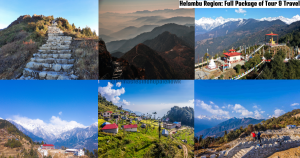
Ama Yangri
Ama Yangri is a sacred mountain located in the Helambu Region, Sindhupalchowk district of Nepal. Situated at an elevation of approximately 3,800 meters (12,467 feet) above sea level, Ama Yangri holds significant religious and cultural importance for the local communities. The term "Ama" means mother in the Nepali language, and Ama Yangri is often referred to as the "Mother of the Universe" or the "Goddess of Power." It is believed to be a manifestation of the powerful Hindu goddess, Bhagwati. The mountain is considered a revered site for both Hindu and Buddhist pilgrims who undertake arduous journeys to seek blessings and spiritual solace.
Ama Yangri offers breathtaking panoramic views of the surrounding Himalayan peaks, including Langtang, Ganesh Himal, and Dorje Lakpa. The pristine natural beauty of the region, coupled with the serene and spiritual atmosphere, makes it a popular destination for trekkers and nature enthusiasts.
As hikers make their way up towards Ama Yangri, they pass a number of sacred sites including temples and monasteries. These places have deep religious significance and serve as stopping points for pilgrims to pray and ask for blessings. Ama Yangri's journey to the top is often seen as a spiritual quest, a test of endurance, and an opportunity for introspection.
Read Also:
Once at the top, hikers will be rewarded with stunning surroundings and a closer feeling of the divine. The serene and peaceful atmosphere, coupled with the stunning views, creates a feeling of awe and reverence. Ama Yangri also plays an important role in conserving the biodiversity and natural resources of the area. The mountain and its surroundings are home to a wide variety of flora and fauna, including endangered species such as red pandas and musk deer. Efforts are made to promote sustainable tourism practices and maintain the ecological balance of the area.
Ama Yangri Sindhupalchowk is a witness to Nepal's rich spiritual and cultural heritage. The awe-inspiring beauty, religious significance and challenging journey to the top continue to captivate the hearts and minds of all who venture to explore its sacred slopes.
Things to do in Ama Yangri
Trekking: Ama Yangri offers excellent trekking opportunities, allowing you to explore stunning landscapes and panoramic views of the Himalayas. The hike to the summit is a challenging yet rewarding experience, taking you through picturesque villages, forests, and alpine meadows.
Cultural expedition: The area around Ama Yangri is rich in cultural heritage. Take the opportunity to interact with local communities, learn about their traditions and witness their vibrant festivals and ceremonies. Visit nearby villages to observe traditional farming practices, sample local cuisine and experience the warm hospitality of the locals.
Camping: Ama Yangri offers ideal camping sites for those seeking an immersive experience in nature. Set up camp under the starry skies, enjoy a bonfire, and listen to the sounds of nature as you spend a night amidst the tranquil surroundings. Camping is a great way to disconnect from the outside world and rejuvenate your senses.
Take photos and take a walk in the middle of nature: Ama Yangri and its surroundings offer stunning natural beauty and breathtaking views. Embark on nature hikes to discover the diversity of flora and fauna, capture the majestic peaks of the Himalayas on your camera, and immerse yourself in the serene atmosphere of the mountains.
See wildlife: The Sindhupalchowk area is home to many different species of wildlife. Keep an eye out for the elusive red panda, musk deer and a variety of birds as you explore the forests and grasslands. Take part in bird-watching and wildlife-watching activities for a chance to get closer to the area's biodiversity.
Best Season to Visit
The best seasons to visit Ama Yangri are spring and autumn when the most favourable weather and hiking conditions are available. Here are the details for each season:
Spring (March to May): Spring is considered the most beautiful season to visit Ama Yangri. During this time, the weather is mild and the skies are usually clear blue, offering excellent views of the surrounding mountains. Temperatures start to rise and the rhododendron forests come to life with vibrant colours, creating a picturesque setting. This is an ideal time for trekking, as the trails are in good condition and the blooming flowers add to the beauty of the area.
Autumn (September to November): Autumn is another favourable season to visit Ama Yangri. The weather remains dry and the skies clear, offering spectacular mountain views. Temperatures are mild during the day and can be chilly at night. The fall months are also the harvest season and you can find local communities organizing various festivals and cultural events. Well-defined hiking trails and stable weather conditions make it an ideal time for outdoor activities.
It is important to note that Ama Yangri is located at a higher elevation and the weather can be unpredictable even in the best seasons. It is advisable to check the weather forecast and be prepared for sudden changes in weather conditions. In addition, the winter months (December to February) can be very cold, with heavy snowfall, making climbing and outdoor activities difficult. Monsoon season (June to August) brings heavy rain, making the roads slippery and visibility less clear, so it's usually not a good time to visit.
Route To Ama Yangri
The best route to Ama Yangri is:
From Kathmandu to Melamchi Bazar: Start your trip from Kathmandu and head to Melamchi Bazaar. You can hire a private vehicle or take a public bus from Kathmandu to Melamchi Bazar, which is about 57 kilometres (35 miles). The journey takes about 3-4 hours, depending on road and traffic conditions.
Melamchi Bazar to Tarkeghyang: From Melamchi Bazar, a walking trail leads to Tarkeghyang, a charming Sherpa village located at an elevation of about 2,560 meters (8,399 feet). The walking path offers panoramic views of the rice terraces, forests and traditional houses. Normally it will take you about 5-6 hours to reach Tarkeghyang, where you can rest for the night.
Tarkeghyang to Shermathang: From Tarkeghyang, continue your journey to Shermathang. The trail passes through beautiful rhododendron forests, with occasional views of the snow-capped mountains. Shermathang is another picturesque Sherpa village located at an elevation of about 2,610 meters (8,563 ft). The trip from Tarkeghyang to Shermathang takes about 3-4 hours.
Shermathang to Ama Yangri: From Shermathang, you will continue your journey to Ama Yangri. The path gradually climbs through dense forests and opens up to beautiful views of the Himalayas. After a hike of about 5-6 hours, you will reach Ama Yangri base, located at an altitude of about 3,000 meters (9,842 feet). Take time to rest and prepare for the final leg of the climb.
Ama Yangri Summit: From the base camp, make the final climb to the top of Ama Yangri. The trail is uphill and difficult, requiring suitable climbing gear and fitness. When you reach the summit at about 3,800 meters (12,467 feet), you'll be rewarded with impressive panoramic views of the surrounding mountains and valleys.




